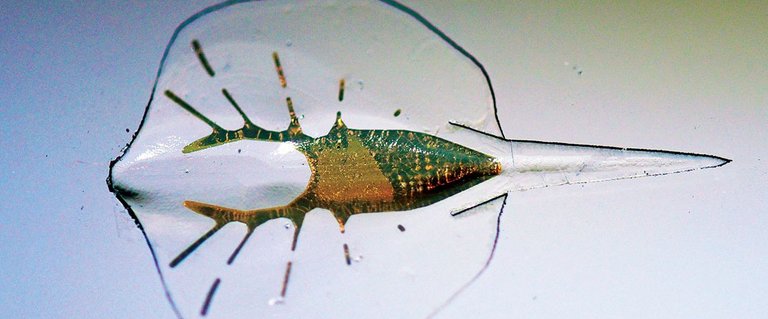Source

Before seeing if it is necessary to regulate it, it is advisable to understand what this technology is about. Biohybrid robotics is a discipline in which the best of two worlds are combined: the artificial and the biological, in order to create systems that integrate artificial components (such as sensors, actuators or structures) with living tissues and cells.
Antes de ver si es necesario regularla es conveniente entender de qué se trata esta tecnología. La robótica biohíbrida es una disciplina en la que se combina lo mejor de dos mundos: lo artificial y lo biológico, con el fin de crear sistemas que integran componentes artificiales (como sensores, actuadores o estructuras) con tejidos y células vivas.
A priori it might seem a bit exaggerated to worry about these things but the truth is that biohybrid robotics is advancing by leaps and bounds. There are already prototypes capable of performing simple tasks such as grabbing objects, swimming or crawling, using cultured muscle tissues to generate movement, which is a very significant advance.
A priori podría parecer un poco exagerado preocuparse por estas cosas pero lo cierto es que la robótica biohíbrida avanza a pasos agigantados. Ya existen prototipos capaces de realizar tareas sencillas como agarrar objetos, nadar o arrastrarse, utilizando tejidos musculares cultivados para generar movimiento, lo cual es un avance muy significativo.
Source

The rapid evolution of this technology raises a series of ethical and social questions that require attention, which is why a multidisciplinary team from the University of Southampton (United Kingdom), in collaboration with universities in the United States and Spain, have published an article in which they explain the possible problems of this technology.
La rápida evolución de esta tecnología plantea una serie de interrogantes éticas y sociales que requieren atención, por eso un equipo multidisciplinario de la Universidad de Southampton (Reino Unido), en colaboración con universidades de Estados Unidos y España han publicado un artículo en el que exponen lo posibles problemas de esta tecnología.
Some of their doubts are: How will these biorobots interact with the environment and with us? Could they alter ecosystems or generate new biological risks? and if we use biorobots as organs or limbs, what will be the long-term implications for our health and our identity? Where does the human end and the robot begin?
Algunas de sus dudas son: ¿Cómo interactuarán estos biorobots con el medio ambiente y con nosotros? ¿Podrían alterar ecosistemas o generar nuevos riesgos biológicos? y si utilizamos biorobots como órganos o extremidades, ¿Cuáles serán las implicaciones a largo plazo para nuestra salud y nuestra identidad?, ¿Dónde termina el humano y empieza el robot?.
Source

That is why these scientists demand a regulation that guides the development of this technology in a responsible and ethical manner, that guarantees that biorobots will not represent a danger to human health or the environment or define who is responsible in the event that a biorobot causes any harm, among many other things that will arise.
Por eso estos científicos reclaman una regulación que guíe el desarrollo de esta tecnología de manera responsable y ética, que garantice que los biorobots no representarán un peligro para la salud humana o el medio ambiente o definir quién es responsable en caso de que un biorobot cause algún daño, entre otras muchas cosas que irán surgiendo.
What amazes me the most is to think that, when Terminator was released in 1985, with a metal endoskeleton covered by living tissue, none of us viewers at that time thought we would see something like that and now they are already looking for ways to regulate our coexistence with them and even to merge with them.
Lo que más me alucina es pensar que, cuando se estrenó Terminator en el año 1985, con un endoesqueleto de metal cubierto por tejido vivo, ninguno de los espectadores de aquel momento pensábamos que llegaríamos a ver algo así y ahora ya están buscando como regular nuestra convivencia con ellos e incluso para fusionarnos con ellos.
More information/Más información
https://www.meche.engineering.cmu.edu/news/2024/07/22-biohybridethics.html
Has sido votado por
PROYECTO ENLACE
'Conectando Ideas y Comunidades'
PROYECTO ENLACE es un proyecto de curación de habla hispana enfocado en recompensar contenido de calidad y apoyar autores en su proceso de crecimiento en HIVE.
Creemos y apostamos por el futuro de esta gran plataforma, y estamos muy emocionados de poder hacerla crecer junto a esta comunidad. Así que te invitamos a publicar en nuestra COMUNIDAD y estar atento a todas las actividades que tenemos preparadas y que estaremos publicando en breve.
¿QUIERES AUTOMATIZAR TUS GANANCIAS DE CURACIÓN? SE PARTE DEL PROYECTO ENLACE APOYANDO A NUESTRO TRAIL EN HIVE.VOTE INGRESA AQUÍ PARA CONOCER LOS DETALLES.
¿QUIERES INVERTIR ENLACE? DESCUBRE COMO HACERLO Y GENERAR INGRESOS DE FORMA SEMANAL MEDIANTE TU DELEGACIÓN DE HP AQUÍ TE EXPLICAMOS COMO.
Te invitamos a participar en nuestro servidor de Discord: https://discord.gg/3S9y7BbWfS
Atentamente
EQUIPO ENLACE 2024
Thx
The potential for biohybrid robots to impact ecosystems and human health is both exciting and pretty concerning. I have to say, I'm so glad whenever I see new tech from science, it shows our progress as a race
To an extent I am still having mixed feelings to the development and advancement of robots in our society. Actually I know they have good benefits but what about you ye side effects of them